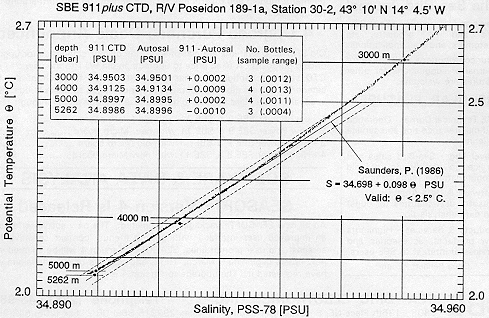![]()
A publication of Sea-Bird Electronics, Inc. Issue #2 Mar 1992
SEA-BiIRD WINS CTD TEST BY IFM-KIEL
In a second independent CTD trial by a leading institution, Sea-Bird's 911plus CTD gave the best results in every test conducted by Dr. Thomas J. Müller of the Institut Für Meereskunde an der Universität Kiel (IFM-Kiel). This second win yielded results similar to those in tests conducted in May, 1991 by the Bedford Institute of Oceanography (see Sea-Bird Journal Issue #1).
The 911plus CTD, and three other CTDs (NBIS Mk III, EG&G Mk V, FSI Triton) were tested on board the FS Poseidon during a cruise from Hamburg, Germany to Las Palmas, Canary Islands, 16 to 31 January 1992. The most demanding tests were conducted at depths over 5000 meters in waters having a well-known theta-S relationship and in the T-S step-structure below the Mediterranean water tongue. In the figure below, a down-and-up theta-S plot of 911plus data is compared to the N.E. Atlantic historic theta-S relationship (solid curve; Saunders, 1986, JPO, v.16(1), p189-195), and found to fall within the 0.002 PSU rms tolerance of the Saunders parameterization (dashed lines). Hysteresis of less than 0.001 PSU is nearly imperceptible.
"Congratulations, that is perfect salinity."
The Sea-Bird data also agree with averaged bottle values from 3000 to 5262 meters (dots and table) to within 0.001 PSU, and every bottle value agreed with 911plus salinity to better than 0.003 PSU at all depths. The 911plus CTD achieved and sustained this performance over the entire cruise "as delivered", without calibration adjustments. Chief Scientist, Dr. T. J. Müller, was so impressed with the performance that he offered, "Congratulations, that is perfect salinity."
The 911 plus CTD's new modem telemetry link had 100% success controlling a General Oceanics rosette water sampler. 96 bottles and over 100 "dry firings" were actuated and confirmed. After the trials, the 911plus CTD remained on board, where scientists from the University of Las Palmas, cooperating with IFM on a second cruise leg, were also impressed with their first-time use of with the Sea-Bird system. They have initiated purchase of their own 911plusCTD.
Post-cruise calibration testing of the 911plus CTD is underway at IFM-Kiel. Dr. Müller's report on the trial results is expected in 2-3 months.

SEACAT NUMBER 1,000 DELIVERED TO MIAMI
On January 16, 1992, Sea-Bird shipped its 1,000th Seacat to the University of Miami (RSMAS). The SBE 16 Seacat moored C-T recorder, serial number 1000 was one of four configured with optional titanium housings and 10,000 psia Paroscientific Digiquartz® pressure sensors.
Each Seacat will be part of an 18- month-long deep current meter mooring. This deployment required very accurate pressure data, provided by the optional Digiquartz® sensors. With a budget-minded view toward deployments over the next decade, the long-term value of all-titanium construction was considered a "plus" in the purchase decision. After receiving the first 4, the University recently requested a quotation for another 4 Seacats.
SBE TECHNICAL CORNER
The output voltage range of the O2 temperature compensation signal on new model SBE 13 Dissolved Oxygen sensors has been changed from ± 5 VDC to 0 to +5 VDC to accommodate the standardization of A/D input channels in the new 911plus CTD. Users should be aware that their older SBE 13 sensors will need to be modified to work with the new 911plus CTD. Sea-Bird will make the modification for free when sensors are sent along with CTDs for upgrade, or provide "do-it-yourself" instructions.
PRODUCTS & SERVICES
Sea-Bird 911plus CTD Introduced at OI-92:
Attendees at the Oceanology International - 92 exhibition in Brighton, U.K. (10-13 March) will see the first public display of Sea-Bird's 911plus CTD with important new operating features and several design refinements in the time-proven SBE 9/11 CTD. Major new features include universal compatibility between all SBE 9plus Underwater Units and all SBE 11plus Deck Units, and a modem telemetry channel for control of rosette samplers or other equipment. In addition to describing the 911plus CTD and its features, our new full-color literature illuminates the engineering choices made in the system design, and explains how those choices are derived from an understanding of the fundamentals of CTD accuracy and validated by performance of the Sea-Bird CTD. Copies will be available at Sea-Bird's OI-92 exhibit, or will be mailed upon request.
Free Upgrade When You Buy a 911plus CTD:
Sea-Bird will upgrade your old 9/11 CTD to the new standard 911plus configuration for free (excluding shipping charges), when you buy a new 911plus CTD between now and December 31, 1993. Contact Sea-Bird Sales or Customer Service about adding optional new features like the telemetry modem and rosette interface, or scheduling and turn-around time for upgrades.
4 Upgrade Purchase Deals Announced:
Old 9/11 CTD systems are classified in one of four categories for upgrade pricing purposes. A fixed price to upgrade an old 9/11 to the new 911plus CTD standard configuration has been established for each of the four categories. Users desiring upgrades are encouraged to make budget plans in advance. Sea-Bird intends to honor these upgrade prices through 1993. 1 - Low Power SBE 9 & SBE 11 with old Micro board ................ $9,405
2 - Low Power SBE 9 & SBE 11 with new Micro board .............. $8,525
3 - High Power SBE 9 & SBE 11 with old Micro board ............... $8,615
4 - High Power SBE 9 & SBE 11 with new Micro board ............. $7,735
SOFTWARE & DATA ANALYSIS
Seasoft© Version 4 Is Released:
An all new Seasoft© package is completed. The new software features an improved user interface with pop-up menus, context sensitive help screens, and user prompt lines. Seasoft Version 4 will be shipped with new orders beginning 9 March, 1992, and to users of older versions who have requested it. The upgrade to version 4 is free.
![]()
Sea-Bird Home Phone: (+1) 425-643-9866 E-mail: seabird@seabird.com